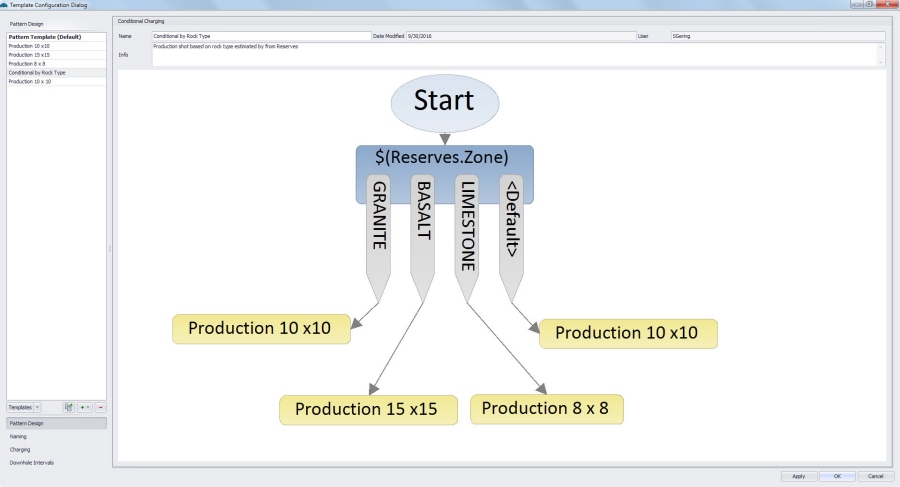HxM Blast is now fully integrated with the block model to provide engineers with faster and more accurate blast designs.
Coupled with the ability to measure actual data from the field, analyze the results of a blast based on the block model and other systems, and finally store blast settings as conditional templates, HxM Blast continues to improve blast design workflows and reconciliation. Integrated options, such as direct block model access, export to major explosives contractors, and reserves allow you to use values in the block model such as rock type, fragmentation, ore classification, and economics to quickly evaluate best practices, understand what is making those patterns successful, and accurately report the results. This process of continuous improvement can be simplified in the figure below as Design, Measure, Analyze, and Improve.

Figure 1: Generalized process of continuous improvement used in blasting.
Many mines are data-rich and information-poor. Most systems in the mine generate a tremendous amount of useful information without an easy method for quickly integrating and aggregating that information for decision-making.
For drill and blast this is particularly challenging because even simple blast designs require expert knowledge of the previous blast, rock properties, fragmentation requirements, costs, safety, water, explosives, scheduling, and project management. While it is possible to gather this information from all the different systems available, it is often acquired too late to be used for making decisions for the current blast; or it relies on complex scripted solutions that are difficult to manage and validate.
To set up a standardized and transparent process for continuous improvement, drill and blast engineers and managers need access to information quickly and easily for both designing new blasts and evaluating their effectiveness. As lessons are learned, that information needs to be documented and shared with the organization so it can be applied in the future.
Solution
HxM Blast is the solution! HxM Blast provides tools for you to design blasts, import blast-related information from virtually any system, and use that information to standardize and optimize the drill and blast workflow. It empowers you to construct workflows based on information from the block model and other systems, and to store that information as templates for later use by the design engineer.
Drill and Blast Design
A simple case is illustrated below based on rock type from the model. In this scenario, the pattern template best suited for a particular rock type can be defined using a conditional logic defined by the user. Any property can be used to build the template. This could include penetration rates, rock hardness, and ore classification.

Figure 2: Integration with the block model is one source for creating conditional templates for designing and charging the holes. This information can be read directly into Blast and stored as templates, as seen in Figure 3.

Figure 3: Conditional design and charging templates based on block model or other parameters allow sites to standardize and gradually improve their site blasting models.
Measure
Measurements from the field can be imported to HxM Blast using single or multiple blasts based in Hole ID or spatial location directly from the database. Properties imported and stored in the repository allow engineers to create more accurate designs by using actual data from the field. For example, charge designs can be created directly visuali~ing the block model and charged using the same conditional logic used in the design process.

Figure 4: Water level surfaces and visual charging information provide opportunities to measure data in the field and then use that information to optimize blast design.
Analyze
Integration with the block model allows you to evaluate the blast and identify where the design is working well and where improvements can be made. For example, rock type can be compared with penetration rates, shovel dig rates, and fragmentation. The built-in ARC utility shows charts and graphs and advanced analysis of the blast.

Figure 5: Built-in ARC reporting allows you to quickly generate reports and compare planned vs. actual data from the field in order to make data-driven decisions.
Improve
Equipped with this information in HxM Blast, you can make improvements to blast design, charging, grade control, and scheduling. The design and charge templates can be updated and used as a basis for the next blast. This process of continuous improvement in blasting is critical for maintaining safety and sharing knowledge between multiple users. HxM Blast allows everyone to know how and why the blast was designed, as well as the the overall performance. Additionally, if you change there will always be a record of the decision-making process.

Figure 6: Centralized drill and blast data stored in a SQL database allows you to construct powerful visualizations that quickly aggregate and evaluate blasting in order to understand and improve workflows.
Conclusion
HxM Blast closes the loop on efficient and rapid blast design by allowing data from multiple systems, the block model, and drill, to improve blast design, reconciliation, and safety in the mine.